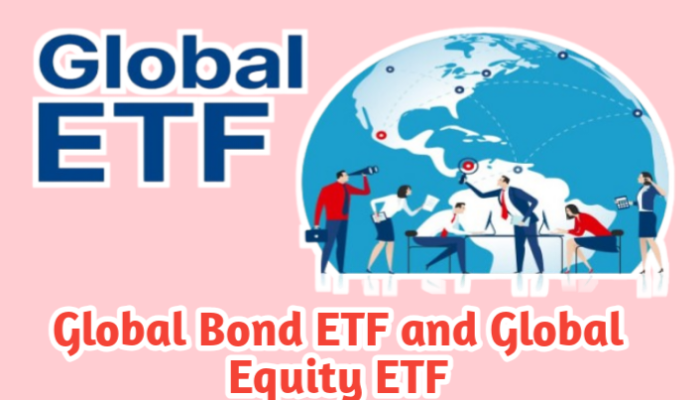A Global Bond ETF is an exchange-traded fund that invests in bonds issued by governments, corporations, and institutions across the world. Unlike buying individual bonds, investors gain instant diversification in international fixed-income markets through a single ETF.
1. What is a Bond ETF?
A Bond ETF tracks an index or portfolio of bonds. Instead of holding bonds directly until maturity, investors trade ETF shares on exchanges, making bond investing more liquid and accessible.
2. Difference Between Domestic and Global Bond ETFs
| Feature | Domestic Bond ETF | Global Bond ETF |
|---|---|---|
| Scope | Bonds from one country | Bonds from multiple countries |
| Currency Exposure | Single currency | Multiple currencies |
| Diversification | Limited | Broader, across regions |
| Risk | Lower (home market only) | Higher (currency & global risk) |
3. Types of Global Bond ETFs
- Government Bond ETFs – Invest in sovereign bonds (e.g., US Treasuries, Japanese bonds).
- Corporate Bond ETFs – Focus on bonds issued by global corporations.
- Emerging Market Bond ETFs – Bonds from developing countries (higher yield, higher risk).
- High-Yield Bond ETFs – “Junk bonds” offering higher returns but with greater risk.
4. Benefits of Investing in Global Bond ETFs
- Diversification across global fixed-income markets
- Lower cost compared to buying individual bonds
- Regular income via bond interest payments
- Access to markets not easily available to individual investors
5. Risks and Challenges of Global Bond ETFs
- Currency Risk: Exposure to foreign exchange fluctuations
- Credit Risk: Default by governments or corporations
- Interest Rate Risk: Bond prices fall when rates rise
- Liquidity Risk: Some bonds may be thinly traded
6. Factors to Consider Before Investing in Global Bond ETFs
- Expense ratio (cost of the ETF)
- Credit ratings of underlying bonds
- Currency exposure and hedging options
- Yield-to-maturity vs. risk trade-off
- Historical performance and tracking error
7. Popular Global Bond ETFs in the Market
- iShares Global Govt Bond ETF (IGOV)
- Vanguard Total International Bond ETF (BNDX)
- SPDR Bloomberg International Treasury Bond ETF (BWX)
- iShares J.P. Morgan USD Emerging Markets Bond ETF (EMB)
8. How to Buy and Trade Global Bond ETFs
- Open a brokerage account (international access required)
- Choose ETF based on your investment goal
- Trade like stocks on major exchanges (NYSE, NASDAQ, LSE, etc.)
- Monitor performance, interest payments, and global economic trends
9. Role of Global Bond ETFs in a Diversified Portfolio
Global Bond ETFs provide stability and income, balancing the volatility of equities. They are particularly useful for risk-averse investors or those near retirement.
10. Conclusion
If your goal is steady income and diversification across global markets, Global Bond ETFs are a strong choice. However, consider currency risk and economic stability of issuing countries before investing.
Global Equity ETFs
A Global Equity ETF invests in stocks from companies worldwide. Instead of focusing on a single country’s stock market, these ETFs provide exposure to multiple regions, industries, and sectors.
1. What is an Equity ETF?
An Equity ETF is an exchange-traded fund that tracks a stock index or basket of stocks. Global versions combine equities from developed and emerging markets into one diversified product.
2. Difference Between Domestic and Global Equity ETFs
| Feature | Domestic Equity ETF | Global Equity ETF |
|---|---|---|
| Scope | One country’s stock market | Multiple international markets |
| Diversification | Limited | Global exposure across regions |
| Currency Risk | Low (single currency) | Higher (multiple currencies) |
| Growth Potential | Tied to one economy | Taps into worldwide growth |
3. Types of Global Equity ETFs
- Developed Market Equity ETFs – Focus on US, Europe, Japan, and other mature economies.
- Emerging Market Equity ETFs – Invest in high-growth economies like India, Brazil, China.
- Sector-Specific Global Equity ETFs – Concentrate on industries like technology, healthcare, or energy worldwide.
- Thematic Global Equity ETFs – Target global themes such as renewable energy, AI, or ESG (Environmental, Social, Governance).
4. Benefits of Investing in Global Equity ETFs
- Exposure to global economic growth
- Diversification across regions and industries
- Lower cost compared to investing in multiple countries individually
- Potential for higher long-term returns compared to bonds
5. Risks and Challenges of Global Equity ETFs
- Market Risk: Stocks are more volatile than bonds
- Currency Risk: Returns may vary with FX movements
- Geopolitical Risk: Instability in certain countries can affect returns
- Concentration Risk: Some ETFs may be heavily weighted towards US or tech stocks
6. Factors to Consider Before Investing in Global Equity ETFs
- Index tracked (MSCI World, FTSE Global All Cap, etc.)
- Geographic allocation (Developed vs Emerging Markets)
- Expense ratio and liquidity
- Dividend yield vs. growth focus
- Long-term vs short-term investment goals
7. Popular Global Equity ETFs in the Market
- Vanguard Total World Stock ETF (VT)
- iShares MSCI ACWI ETF (ACWI)
- SPDR MSCI World ETF (URTH)
- iShares MSCI Emerging Markets ETF (EEM)
8. How to Buy and Trade Global Equity ETFs
- Open a brokerage account
- Choose ETF based on geographic focus and expense ratio
- Trade ETF shares like stocks on global exchanges
- Consider tax implications in your country
9. Role of Global Equity ETFs in a Diversified Portfolio
Global Equity ETFs are best suited for growth-oriented investors. They balance exposure between developed and emerging markets, reducing reliance on one economy while capturing worldwide opportunities.
10. Conclusion
If your goal is long-term capital appreciation and exposure to global growth trends, Global Equity ETFs are a strong option. They are ideal for younger investors or those seeking portfolio diversification beyond domestic markets.
Global Bond ETF vs Global Equity ETF
📊 Comparison Table
| Feature | Global Bond ETF | Global Equity ETF |
|---|---|---|
| Asset Type | Bonds (Fixed Income) | Stocks (Equities) |
| Risk Level | Lower (stable returns) | Higher (volatile returns) |
| Return Potential | Moderate (3–6% annually) | High (can exceed 8–12% annually) |
| Income | Regular interest payments | Dividends (if applicable) |
| Best For | Risk-averse, income-focused investors | Growth-oriented, long-term investors |
| Currency Impact | Significant (foreign bonds) | Significant (foreign equities) |
| Example ETFs | BNDX, IGOV, EMB | VT, ACWI, URTH |
Final
Both Global Bond ETFs and Global Equity ETFs have a vital role in building a well-diversified portfolio:
- Bonds provide income and stability
- Equities provide growth and wealth creation
A balanced portfolio often includes both, depending on age, risk tolerance, and financial goals.

















